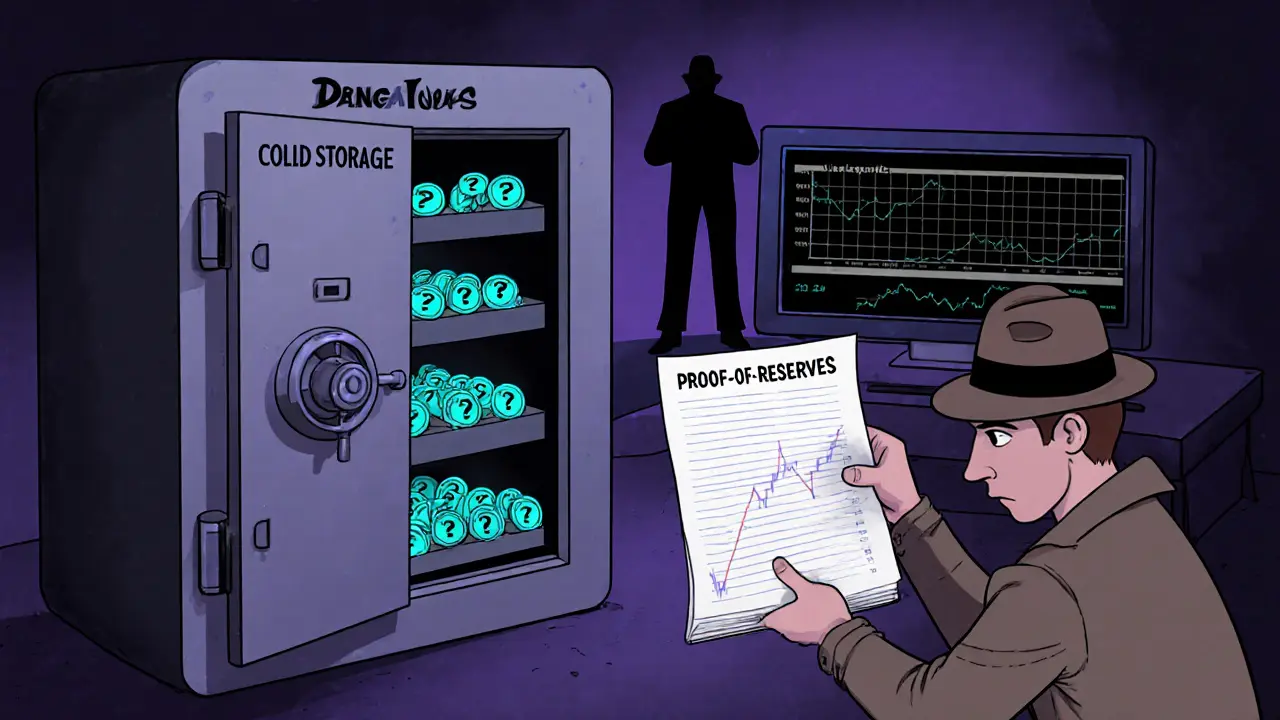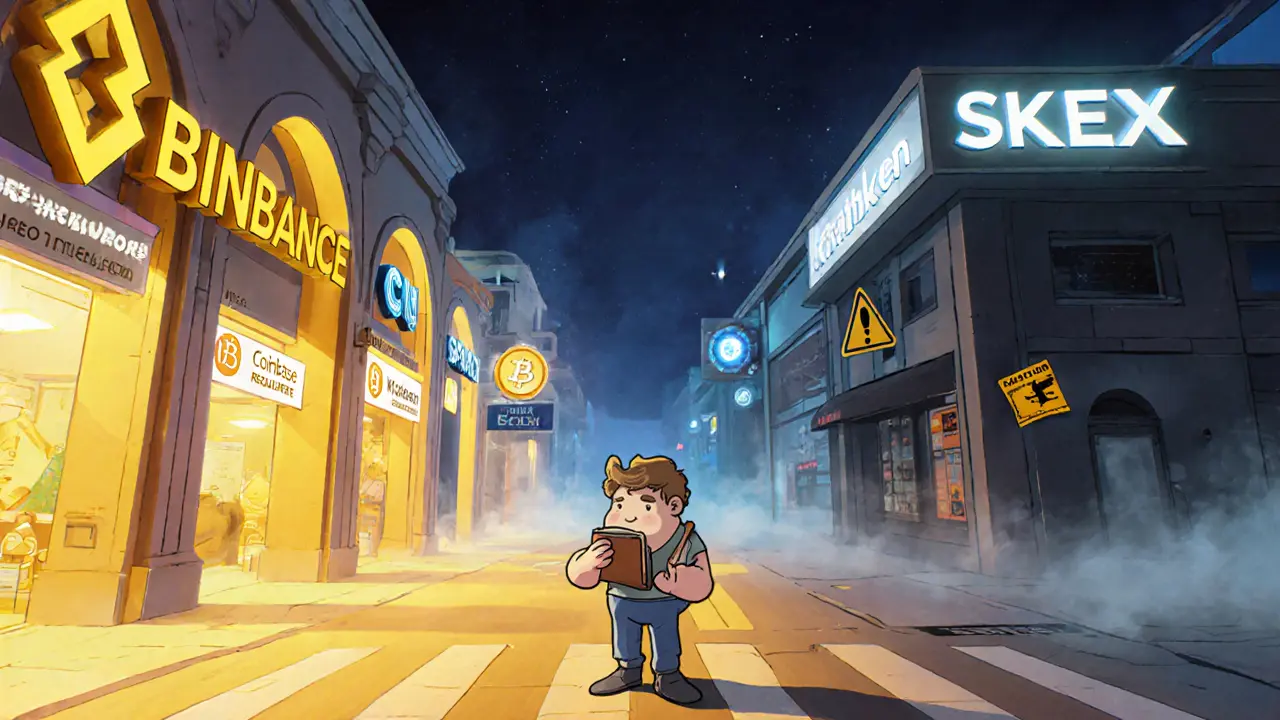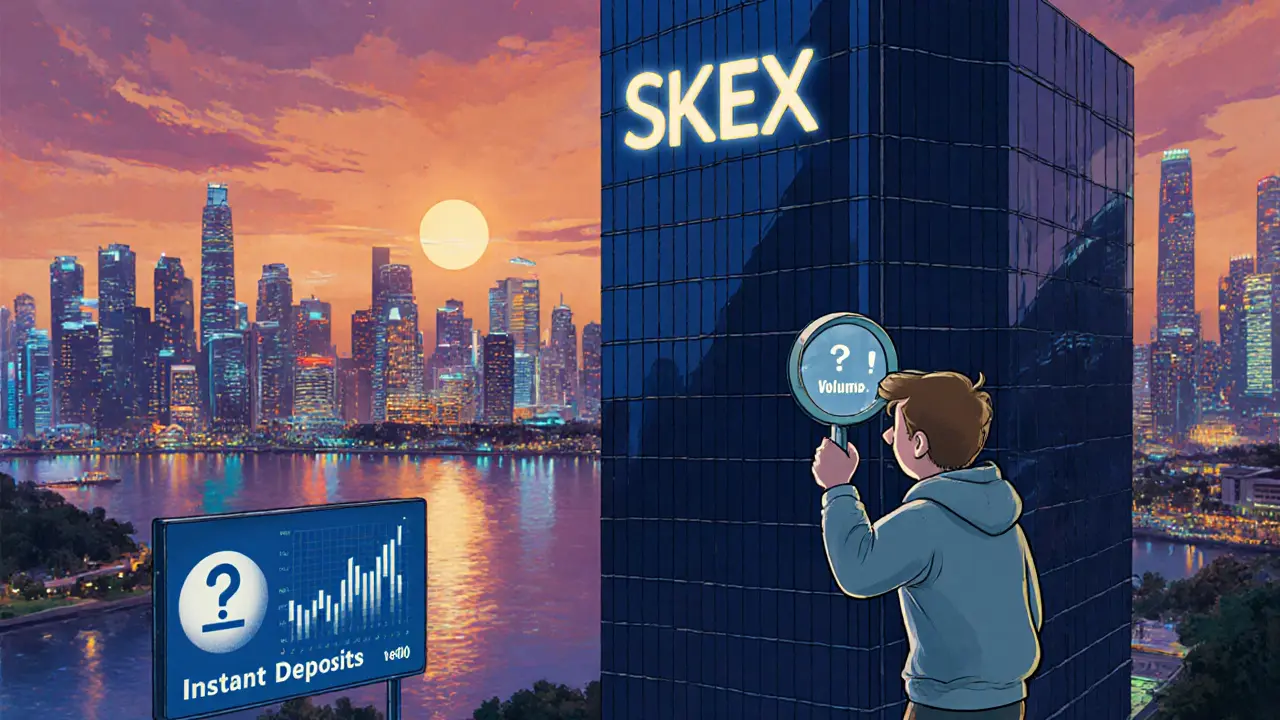Crypto Exchange Transparency Calculator
How Transparent is Your Exchange?
Calculate a transparency score based on key security and trust factors. Scores below 50 indicate significant risk.
Transparency Score
How This Compares to Major Exchanges
- Binance 95/100
- Coinbase 85/100
- Kraken 80/100
- SKEX 20/100
Key Takeaways
- SKEX is a Singapore‑based centralized exchange that launched in September2019 but provides no public trading‑volume or reserve data.
- Unlike top exchanges, SKEX offers no clear proof‑of‑reserves, cold‑storage percentages, or regulatory licensing from MAS.
- Community sentiment is virtually non‑existent, which is a major red flag for new users.
- Compared with Binance, Coinbase and Kraken, SKEX falls short on transparency, liquidity and security.
- For most traders, staying away from SKEX until it publishes verifiable metrics is the safest move.
When you hear the name SKEX is a Singapore‑based centralized cryptocurrency exchange that launched in September2019, the first question is whether it’s trustworthy. The exchange appears on CoinMarketCap, yet it hides the data that most traders rely on: real‑time volume, reserve proof and regulatory status. Below is a deep dive into what we know, where the gaps are, and what that means for anyone thinking about putting money on the platform.
What SKEX Claims to Be
SKEX markets itself as a full‑service crypto broker, offering spot trading, futures contracts and a native token (SKX). Its website lists a sleek UI and promises “instant deposits” and “24/7 support,” but none of these claims are backed by third‑party audits or public documentation. The lack of detail makes it hard to verify basic attributes such as supported cryptocurrencies, fee schedule or KYC requirements.
Transparency Gaps: No Volume, No Reserves
In the post‑FTX world, traders demand two things from any exchange: visible 24‑hour trading volume and proof‑of‑reserves. Both metrics let you gauge liquidity and ensure the platform actually holds the assets it says it does. SKEX shows zero volume on its public dashboard and offers no proof‑of‑reserves page. This omission is a classic warning sign - either the exchange is still building infrastructure (unlikely after four years) or it is deliberately masking low liquidity.

Security and Custody: Cold Storage and Wash‑Trading Concerns
Established exchanges openly publish the percentage of funds kept in offline cold storage (usually 95‑98%). SKEX provides no such figures, leaving users in the dark about how much of their crypto is vulnerable to hacks. Moreover, the absence of volume data fuels speculation about wash‑trading - a practice where an exchange fabricates activity to appear liquid. Without independent audits, it’s impossible to rule out this risk.
Regulatory Status - Does MAS Approve SKEX?
The Monetary Authority of Singapore (MAS) requires all crypto exchanges operating in the country to obtain a Major Payment Institution licence. This process involves rigorous financial scrutiny and ongoing compliance reporting. There is no public record of SKEX holding such a licence, nor any mention in MAS’s official registry. By contrast, competitors like Crypto.com and Independent Reserve openly display their regulatory approvals, which builds user confidence.
How SKEX Stacks Up Against the Leaders
Below is a quick side‑by‑side look at the most important factors for evaluating an exchange. The data for Binance, Coinbase and Kraken comes from their latest public disclosures (2024 Q3). SKEX’s cells are marked “N/A” where information is missing.
| Feature | SKEX | Binance | Coinbase | Kraken |
|---|---|---|---|---|
| Launch Year | 2019 | 2017 | 2012 | 2011 |
| 24‑Hour Volume (USD) | N/A | $72B | $12.5B | $5.8B |
| Proof‑of‑Reserves | No public data | Quarterly audit | Monthly proof‑of‑reserves | Quarterly audit |
| Cold‑Storage % | Undisclosed | ~98% | ~96% | ~95% |
| MAS Licence | No evidence | No (operates globally) | No (U.S. regulated) | No (U.S. regulated) |
| Customer Support Avg. Response | Undocumented | Under 2hrs | Under 2hrs | Under 2hrs |

User Experience - What We Can (and Can’t) Verify
Because SKEX’s onboarding flow isn’t publicly documented, we can’t confirm typical KYC steps, verification times or fee structures. Major exchanges charge a base trading fee of 0.1% (Binance) or 0.5% (Coinbase) with volume‑based discounts. SKEX’s fee schedule is absent, leaving traders guessing about hidden costs.
Community chatter is another clue. Platforms like Trustpilot, Reddit’s r/CryptoCurrency and Bitcointalk have zero meaningful threads discussing SKEX. In contrast, even niche exchanges accumulate hundreds of reviews over a few years. The silence suggests either a tiny user base or a platform that discourages public discussion.
Key Risks to Keep in Mind
- Liquidity Risk: Without verifiable volume, orders may slip or fail to fill.
- Custody Risk: No cold‑storage disclosure means funds could be exposed to hacks.
- Regulatory Risk: Operating without MAS approval could lead to enforcement actions or forced shutdown.
- Transparency Risk: No proof‑of‑reserves or audit reports make it impossible to trust the balance sheet.
- Support Risk: Lack of documented support channels can leave users stranded during issues.
Should You Trade on SKEX?
If you value transparent metrics, solid regulatory footing and a proven track record, SKEX falls short on every front. The safest move for most traders is to stick with exchanges that publish real‑time volume, undergo regular audits and hold the appropriate licenses. Until SKEX releases verifiable data, the platform remains a high‑risk gamble.
That said, some users chase native tokens that are only listed on niche platforms. If you’re considering SKX specifically, weigh the potential upside against the risks outlined above and consider keeping exposure small.
Quick FAQ
Is SKEX a regulated exchange?
No public record shows that SKEX holds a licence from the Monetary Authority of Singapore or any other major regulator. This lack of licensing is a major red flag.
Can I see SKEX’s trading volume?
SKEX does not display any 24‑hour volume on its website or on aggregators like CoinGecko. The platform’s volume is effectively hidden.
Does SKEX offer proof‑of‑reserves?
No. There is no public proof‑of‑reserves page or third‑party audit report for SKEX, making it impossible to verify that user funds are fully backed.
How does SKEXcompare to Binance on fees?
Binance publishes a clear 0.1% maker‑taker fee structure with discounts for high volume. SKEX does not publish any fee schedule, so users cannot reliably compare costs.
Is it safe to store large amounts of crypto on SKEX?
Given the unknown cold‑storage practices, missing proof‑of‑reserves and lack of regulatory oversight, storing large balances on SKEX is considered unsafe by most security experts.
Bottom line: the exchange’s biggest selling point - its Singapore base - doesn’t translate into credibility without the accompanying transparency metrics. Until those gaps close, treat the SKEX crypto exchange like any other black‑box platform: proceed with extreme caution or avoid altogether.


ചഞ്ചൽ അനസൂയ
October 12, 2025 AT 08:28Hey folks, diving into SKEX feels like stepping into a foggy marketplace.
Even if the numbers are hidden, we can still practice due diligence and protect our capital.
Think of it as a meditation on risk – breathe, verify, and only allocate what you’re comfortable losing.
Stay curious and keep the community vibe positive!
Orlando Lucas
October 15, 2025 AT 05:54When we weigh transparency against convenience, the scales tip sharply toward data. SKEX’s silence on volume and reserves is a red flag that even a relaxed trader can’t ignore. Yet, for those chasing the SKX token, the allure might outweigh the uncertainty, at least in the short run. Remember, optimism works best when it’s backed by solid facts.
Philip Smart
October 18, 2025 AT 03:21Looks like SKEX just hides everything – classic rookie move.
Jacob Moore
October 21, 2025 AT 00:48Quick tip: if you decide to test SKEX, start with the smallest possible deposit and watch how the order book behaves. Check the withdrawal speed with a tiny amount before moving any real funds. Also, keep an eye on community forums for any emerging red flags. Treat it like a sandbox, not a vault.
Emily Kondrk
October 23, 2025 AT 22:14The moment you hand over keys to a black‑box exchange, you’re feeding the shadow network that’s been lurking behind every unnamed wallet. SKEX could be a front for a larger laundering operation, especially with no MAS licence to shine a light. Their silence screams ‘we have something to hide’, and that should set off every alarm in your brain. Trust is earned, not given, and here the price is far too high.
Nathan Van Myall
October 26, 2025 AT 18:41Seeing the lack of proof‑of‑reserves really pushes me to dig deeper into the codebase and any leaked audit reports. When a platform doesn’t showcase its cold‑storage percentages, it raises concerns about how they manage custody. I’ve started compiling a list of similar exchanges that finally released such data, for comparison. It’s a useful habit to benchmark before committing capital.
debby martha
October 29, 2025 AT 16:08lol SKEX got no volme data, so it feels like guessin in the dark. i’d prob just stick wit Binance till they show some real numbers. dont wanna lose my coins on some hidden trap.
Ted Lucas
November 1, 2025 AT 13:34🚀🚀 If you love high‑risk thrill rides, SKEX might feel like a roller‑coaster without seat belts! The drama of chasing SKX on a platform that hides its books can be exhilarating, but also terrifying when the lights go out. Remember, every adrenaline boost should be weighed against a safety net. Stay sharp, and maybe keep most of your stash on a vetted exchange. 🎢
mark noopa
November 4, 2025 AT 11:01In the grand theatre of crypto, SKEX takes the role of a masked actor, daring the audience to applaud without seeing the face.
Theatrical tactics harken back to the days of traditional finance shrouded in opaque vaults, where trust was a currency in itself.
The absence of 24‑hour volume is not a mere oversight, it is a deliberate curtain that filters out scrutiny.
When an exchange refuses to publish proof‑of‑reserves, it invites the whispers of wash‑trading and phantom liquidity.
Regulatory silence from MAS only deepens the mystery, suggesting either a bureaucratic lag or a strategic evasion.
Investors who value security should treat this silence as a warning bell rather than a neutral background noise.
The ecosystem thrives on transparency; without it, the risk of catastrophic loss multiplies exponentially.
Moreover, the hidden fee structure could gnaw away at any profit, turning a seemingly cheap trade into a hidden tax.
From a philosophical standpoint, the exchange embodies the paradox of offering freedom while chaining users with uncertainty.
One might argue that innovation demands boldness, but boldness without accountability is nothing but recklessness.
The crypto community has learned hard lessons from past collapses, and those lessons echo loudly in the case of SKEX.
If you cannot verify that the platform holds the assets you deposit, you are essentially handing over a blank check.
A prudent strategy would be to allocate only a fraction of your portfolio, if any, to such an opaque venue.
Diversify your exposure across vetted exchanges, and keep the bulk of your holdings in cold storage you control.
In sum, SKEX currently sits on the high‑risk end of the spectrum, and caution is not just advisable-it is essential.
💡 Remember, the safest path often looks boring, but it saves you from headline‑making disasters later.
Rama Julianto
November 7, 2025 AT 08:28I’m not buying the optimism you just poured on SKEX; the facts you skim over are the very ones that could wipe you out. Look, the missing MAS licence isn’t a minor detail-it’s a legal blind spot that regulators can slam shut overnight. If you want to stay safe, demand proof‑of‑reserves before you even think about the token’s hype. The market rewards caution, not blind faith.
Helen Fitzgerald
November 10, 2025 AT 05:54I get where you’re coming from, but let’s keep the convo constructive. Even if SKEX looks shady, a small test trade can give us real‑world data on order execution. Share any findings you have, and we’ll all learn together. Community insight beats solitary speculation.
Mureil Stueber
November 13, 2025 AT 03:21The long post paints a vivid picture of risk and it lines up with what we’ve seen elsewhere. Transparency is key and without it the platform feels unsafe. I’d advise anyone eyeing SKEX to keep allocations tiny until the data gap closes. Stay alert and protect your capital.
Leo McCloskey
November 16, 2025 AT 00:48Indeed, dear colleague, the advice is sound, however, one must also consider the ethical dimension, the responsibility we hold as participants in a financial ecosystem, the duty to avoid supporting potentially illicit operations, and the broader impact on market integrity, which cannot be ignored!
arnab nath
November 18, 2025 AT 22:14SKEX’s hidden metrics are a textbook case of information asymmetry, a red flag for any serious trader.
gayle Smith
November 21, 2025 AT 19:41OMG the drama of a secretive exchange is like a thriller novel where the villain never shows his face, and we’re left hanging on every silent tick!
Nina Hall
November 24, 2025 AT 17:08Hey team, even if SKEX looks murky today, keep exploring and stay hopeful – tomorrow might bring that missing transparency!
Manas Patil
November 27, 2025 AT 14:34From a global perspective, platforms that hide data hinder cross‑border trust; let’s champion openness and build a safer crypto world together.